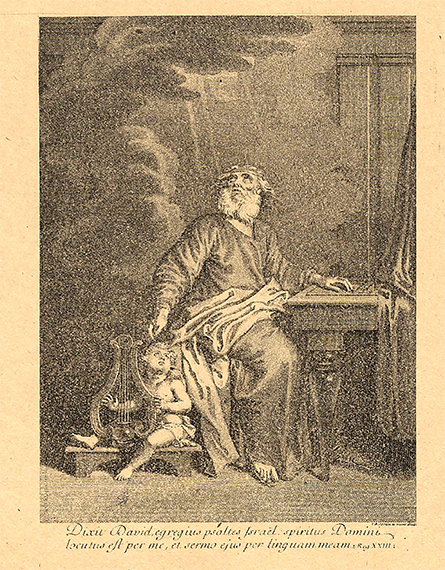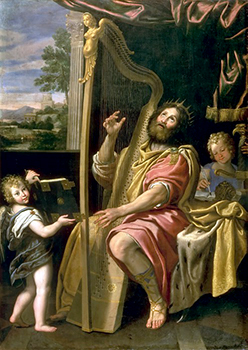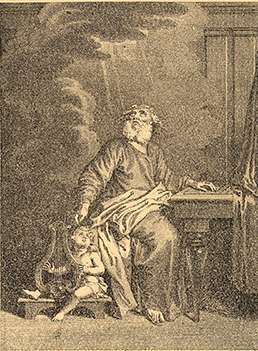
- Home Page
- Accepted
Paintings & Copies - Doubtful
Attributions - Doubtful Textual References
- Alternative
Titles - Collectors &
Museums - Bibliography
- Search Abecedario
- Watteau &
His Circle
David attentif aux inspirations divines
Entered February 2020

Presumed lost
Materials unknown
Measurements unknown
RELATED PRINTS

Gérard Jean-Baptiste Scotin after Watteau, David attentif aux inspirations divines, engraving, c. 1713.
This engraving originally appeared as the frontispiece to the ninth volume of Dom Calmet’s Commentaire litteral sur tous les livres de l’Ancien et du Nouveau Testament. It was then reissued in Jean de Jullienne's Oeuvre gravé.
SELECT BIBLIOGRAPHY
Goncourt, L’Art au XVIIIème siècle (1860), 56.
Goncourt, Catalogue raisonné (1875), cat. 28.
Goncourt, L'Art du dix-huitième siècle (1880), 56.
Guillaume, Watteau (1884), 86.
Dayot, “Antoine Watteau” (1921), 12.
Dacier, Vuaflart, and Hérold, Jean de Jullienne et les graveurs (1921-29), 1: 141-42; 2: 7; 3: cat. 314.
Réau, “Watteau” (1928), cat. 2.
Adhémar, Watteau (1950), 79.
Mathey, Watteau, peintures réapparues (1959), no. 135.
Posner, Watteau (1984), 42, 44.
Whiteley, Drawings in the Ashmolean (2000), under cat. 845.
REMARKS
This composition appeared as the frontispiece to the ninth volume of Dom Calmet’s monumental Commentaire litteral sur tous les livres de l’Ancien et du Nouveau Testament, a learned discourse issued in thirty-three volumes between 1707 and 1716. Written by Dom Augustin Calmet (1672-1757), it was seen as a model of scholarship yet it was also easily accessible. This explains the several editions that were printed in France, and it also was translated into other languages.
Were this academic design not so securely documented, one might well hesitate attributing the composition to Watteau. Yet it is well documented. The inscription on the engraving states: “Votau pinx.” This was written in 1713, just after Watteau was agréé but essentially still unknown. Thus Watteau’s identity would not have added any value. In fact, unfamiliarity with Watteau’s name is evident in it being misspelled as “Votau.” Nevertheless, Mariette recognized Watteau’s authorship and its destination: “Pour le volume des Pseaumes de la Bible de Calmet.”

Domenichino, King David, oil on canvas, 240 x 170 cm. Versailles, Château de Versailles.

Gérard Jean-Baptiste Scotin after Watteau, David attentif aux inspirations divines.
Watteau’s design is surprisingly traditional and can be favorably compared to works by acknowledged Baroque masters such as Domenichino. In both Watteau’s and Domenichino’s versions, the psalmist turns his head heavenward to receive divine inspiration. A young boy holds an open book with verses to guide Domenichino’s king, whereas Watteau shows David at a desk, like an inspired evangelist, receiving the words from God. It should be noted that Domenichino depicts the king playing on a traditional harp whereas Watteau, in accord with Dom Calmet’s learned commentary, Watteau represents the king accompanied by a child who plays a lyre, not a harp.
This commission, not particularly suited to Watteau’s talents, must have come to him through Claude Audran. As Dacier and Vuaflart noted, Audran’s involvement is registered in a contemporary account, Mémoire pour les syndics & jurez de la Communauté des maîtres imprimeurs en taille douce de la Ville de Paris, contre les vendeurs d’images & autres gens sans qualité. There it is stated: “Le sieur Audran des Gobelins . . . dont tout le monde sçait qu’il a entrepris la Bible du P. Calmet.”
The association with Audran coincides with other information regarding Watteau’s career in these years. In very late 1710 he left for Valenciennes and returned to Paris probably not too long thereafter, perhaps some time in 1711 or 1712. He was certainly back by 1712 when he was agréé by the Academy. According to the abbé Leclerc, Watteau worked for Audran before he left for Valenciennes and he resumed working for him when he returned to Paris. Calmet’s book was published in 1713, and his commission must have been received in 1712 or early 1713. It is one of the few fixed points in Watteau’s early chronology, although some would even argue about the date. Posner, for example, claimed that the engraving was done after a painting created a few years earlier.
The legend under the engraving states explicitly “Votau pinx.” But what form did this painting take? Was it a gouache or an oil on paper? One might think of Watteau’s fan design in gouache on paper, La Coquette,and his full-fledged oil modello on canvas, Louis XIV mettant le cordon bleu à M. le duc de Bourgogne. None of the other engravings in Calmet’s Commentaires bear an ascription to Watteau.
Adding to the already problematic nature of this work is a reference in the February 23, 1739, sale of the collection of M. d’Hermand of sixty-five drawings by “Martin” for Calmet’s publication: …1739, lot 10 [under “desseins”] ”Un volume de 65 morceaux dessinez par Martin pour le Dictionnaire de la Bible du Pere Calmet.”